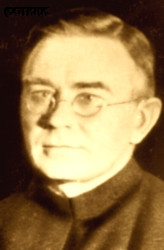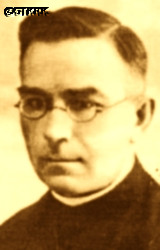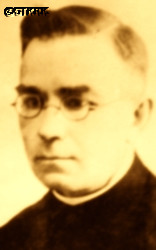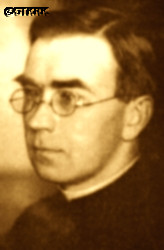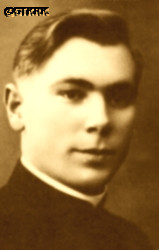Roman Catholic
St Sigismund parish
05-507 Słomczyn
85 Wiślana Str.
Konstancin deanery
Warsaw archdiocese, Poland
full list:
displayClick to display full list

searchClick to search full list by categories
wyświetlKliknij by wyświetlić pełną listę po polsku

szukajKliknij by przeszukać listę wg kategorii po polsku

Martyrology of the clergy — Poland
XX century (1914 – 1989)
personal data
religious status
Servant of God
surname
ANDRIUŠKA
forename(s)
Benedykt
forename(s)
versions/aliases
Benediktas
function
religious cleric
creed
Latin (Roman Catholic) Church RCmore on
en.wikipedia.org
[access: 2014.09.21]
congregation
Society of Jesus SImore on
en.wikipedia.org
[access: 2014.09.21]
(i.e. Jesuits)
diocese / province
Lithuanian province
Lithuanian province
nationality
Lithuanian
date and place
of death
06.02.1951

Verkhneuralsktoday: Verkhneuralsk reg., Chelyabinsk oblast, Russia
more on
en.wikipedia.org
[access: 2022.01.06]
details of death
After German and Russian invasion of Poland in 09.1939 and start of the II World, after start of Lithuanian occupation of part of Polish Vilnius county in 09.1939, after Russian annexation of Lithuania in 06.1940 lived for a time at his friends house in Kaišiadorys diocese.
After end of German occupation, started with German attack on 22.06.1941 of their erstwhile ally, Russians, and start of another Russian occupation arrested on 21.02.1949 in Varlaukis village by Russians.
Held in Lukiškės prison in Vilnius.
Repeatedly interrogated.
Accused of „training youth in a religious and national spirit, systematically making anti–Russian sermons, teaching religion, holding monthly religious conferences, which diverted youth from Communist education, hiding anti–Russian literature”.
On 25.05.1949 sentenced to 10 years in prison.
In 06.1949 transported to Verkhneuralsk prison in Russia.
There perished.
cause of death
extermination
perpetrators
Russians
sites and events
Verkhneuralsk (prison)Click to display the description, GulagClick to display the description, Vilnius (Lukiškės)Click to display the description, Ribbentrop‐MolotovClick to display the description, Pius XI's encyclicalsClick to display the description
date and place
of birth
30.03.1884

Vilkaičiaitoday: Žlibinai eld., Plungė dist., Telšiai Cou., Lithuania
more on
lt.wikipedia.org
[access: 2020.07.31]
parents
ANDRIUŠKA John
🞲 ?, ? — 🕆 1907, ?

🞲 ?, ? — 🕆 1917, ?
religious vows
1905 (temporary)
presbyter (holy orders)
ordination
1915

Ore PlaceHastings
today: non‐existent manor house, East Sussex Cou., England, United Kingdom
more on
en.wikipedia.org
[access: 2021.12.18]
positions held
till 1949
administrator — Varlaukistoday: Eržvilkas eld., Jurbarkas dist., Tauragė Cou., Lithuania
more on
lt.wikipedia.org
[access: 2022.11.09] ⋄ Holy Trinity RC parish ⋄ Tauragėtoday: Tauragė urban eld., Tauragė dist., Tauragė Cou., Lithuania
more on
en.wikipedia.org
[access: 2022.06.29] RC deanery
c. 1948
administrator — Ukrinaitoday: Židikai eld., Mažeikiai dist., Telšiai Cou., Lithuania
more on
en.wikipedia.org
[access: 2022.11.09] ⋄ St Anthony of Padua RC parish
1944 – 1948
superior — Šiauliaitoday: Šiauliai eld., Šiauliai dist., Šiauliai Cou., Lithuania
more on
en.wikipedia.org
[access: 2020.11.13] ⋄ St Ignatius Loyola monastery, Jesuits SI ⋄ St Ignatius Loyola RC church (monastery's) — also: rector of monastery church
c. 1941 – 1944
friar — Pagryžuvystoday: Tytuvėnai eld., Kelmė dist., Šiauliai Cou., Lithuania
more on
lt.wikipedia.org
[access: 2022.06.29] ⋄ monastery, Jesuits SI — lecturer of philosophy for the Order's students
1936 – 1941
Deputy Provincial — Kaunastoday: Kaunas city dist., Kaunas Cou., Lithuania
more on
en.wikipedia.org
[access: 2022.06.29] ⋄ Lithuanian province, Jesuits SI — resident at the Francis Xavier church
1930 – 1936
superior — Šiauliaitoday: Šiauliai eld., Šiauliai dist., Šiauliai Cou., Lithuania
more on
en.wikipedia.org
[access: 2020.11.13] ⋄ St Ignatius Loyola monastery, Jesuits SI ⋄ St Ignatius Loyola RC church (monastery's) — founder; also: rector of monastery church, prefect of a primary school
1923 – 1930
professor — Kaunastoday: Kaunas city dist., Kaunas Cou., Lithuania
more on
en.wikipedia.org
[access: 2022.06.29] ⋄ Theological Seminary — lecturer in Latin, Church History and General History; also: 1926‐1927 editor of the „Zvaigždė” (Eng. „Star”) journal
1921 – 1923
prefect — Antwerptoday: Antwerp prov., Flemish reg., Belgium
more on
en.wikipedia.org
[access: 2021.12.18] ⋄ St Ignatius Loyola University of Commerce, Jesuits SI — also: teacher of Russian language
1920 – 1921
friar — Krakówtoday: Kraków city pov., Lesser Poland voiv., Poland
more on
en.wikipedia.org
[access: 2021.06.07] ⋄ Jesuit Fathers' Publishing House, College (Lat. Collegium Maximum SS. Cordis Iesu, 26 Kopernik Str.), Jesuits SI — publications of books and periodicals in Polish
1919 – 1920
professor — Kaunastoday: Kaunas city dist., Kaunas Cou., Lithuania
more on
en.wikipedia.org
[access: 2022.06.29] ⋄ Theological Seminary — lecturer in philosophy, physics and liturgical singing
1918 – 1919
friar — Londontoday: London Cou., England, United Kingdom
more on
en.wikipedia.org
[access: 2024.03.19] ⋄ residence, Jesuits SI — operarius; also: editor of Lithuanian literature, philosophy studies
1917 – 1918
Third Probation — Canterburytoday: Kent Cou., England, United Kingdom
more on
en.wikipedia.org
[access: 2022.11.09] ⋄ residence, Jesuits SI — also: studies of asceticism
1913 – 1917
student — Ore PlaceHastings
today: non‐existent manor house, East Sussex Cou., England, United Kingdom
more on
en.wikipedia.org
[access: 2021.12.18] ⋄ theology, Theological College (theologate), Jesuits SI
c. 1913
student — Lyontoday: Rodan dep., Auvergne‐Rhône‐Alpes reg., France
more on
en.wikipedia.org
[access: 2022.07.16] ⋄ philosophy and theology, Jesuits SI
1911 – 1913
friar — Bunkovychin .Khyriv
today: Khyriv urban hrom., Sambir rai., Lviv obl., Ukraine
more on
uk.wikipedia.org
[access: 2022.11.09] ⋄ monastery, St Joseph College („Khyriv” Scientific and Educational Institute), Jesuits SI — teacher of Russian language and liturgical singing
1908 – 1911
student — Nowy Sącztoday: Nowy Sącz pov., Lesser Poland voiv., Poland
more on
en.wikipedia.org
[access: 2021.04.01] ⋄ philosophy, Holy Spirit College, Jesuits SI
till 1908
friar — Stara Wieśtoday: Brzozów gm., Brzozów pov., Subcarpathia voiv., Poland
more on
en.wikipedia.org
[access: 2021.12.18] ⋄ Assumption of the Blessed Virgin Mary monastery, Jesuits SI
1903 – 1905
novitiate — Stara Wieśtoday: Brzozów gm., Brzozów pov., Subcarpathia voiv., Poland
more on
en.wikipedia.org
[access: 2021.12.18] ⋄ Assumption of the Blessed Virgin Mary monastery, Jesuits SI
03.03.1903
accession — Stara Wieśtoday: Brzozów gm., Brzozów pov., Subcarpathia voiv., Poland
more on
en.wikipedia.org
[access: 2021.12.18] ⋄ Assumption of the Blessed Virgin Mary monastery, Jesuits SI
1901 – 1903
student — Kaunastoday: Kaunas city dist., Kaunas Cou., Lithuania
more on
en.wikipedia.org
[access: 2022.06.29] ⋄ philosophy and theology, Theological Seminary
author and translator of c. 34 books and brochures, several plays, musical compositions and hymns (published in 1937)
others related
in death
SPERSKIClick to display biography Boleslav, ŠEŠKEVIČIUSClick to display biography Vincent
sites and events
descriptions
Verkhneuralsk (prison): Hard‐labour prison in Verkhneuralsk (Chelyabinsk oblast). Founded in 1914 during Tsarist regime. From 1925 a „politisolator” — prison for political prisoners — initially for prisoner from Solovetsky Islands. Run first by murderous OGPU and then by NKVD, and forming part of Russian system of slave labour Gulag. In 1948 rebranded as special prison. Political prisoners were held there till 1955. (more on: ru.wikipedia.orgClick to attempt to display webpage
[access: 2018.09.02])
Gulag: The acronym Gulag comes from the Rus. Главное управление исправительно‐трудовых лагерей и колоний (Eng. Main Board of Correctional Labor Camps). The network of Russian concentration camps for slave labor was formally established by the decision of the highest Russian authorities on 27.06.1929. Control was taken over by the OGPU, the predecessor of the genocidal NKVD (from 1934) and the MGB (from 1946). Individual gulags (camps) were often established in remote, sparsely populated areas, where industrial or transport facilities important for the Russian state were built. They were modeled on the first „great construction of communism”, the White Sea‐Baltic Canal (1931‐1932), and Naftali Frenkel, of Jewish origin, is considered the creator of the system of using forced slave labor within the Gulag. He went down in history as the author of the principle „We have to squeeze everything out of the prisoner in the first three months — then nothing is there for us”. He was to be the creator, according to Alexander Solzhenitsyn, of the so‐called „Boiler system”, i.e. the dependence of food rations on working out a certain percentage of the norm. The term ZEK — prisoner — i.e. Rus. заключенный‐каналоармец (Eng. canal soldier) — was coined in the ITL BelBaltLag managed by him, and was adopted to mean a prisoner in Russian slave labor camps. Up to 12 mln prisoners were held in Gulag camps at one time, i.e. c. 5% of Russia's population. In his book „The Gulag Archipelago”, Solzhenitsyn estimated that c. 60 mln people were killed in the Gulag until 1956. Formally dissolved on 20.01.1960. (more on: en.wikipedia.orgClick to attempt to display webpage
[access: 2024.04.08])
Vilnius (Lukiškės): Vilnius prison used both by Russians and Germans. Thousands of Poles were kept there. From 2,000 to 16,000 prisoners were jailed at any time there. In 06.1941, after German invasion, Russians murdered most of the prisoners. (more on: en.wikipedia.orgClick to attempt to display webpage
[access: 2021.07.04])
Ribbentrop‐Molotov: Genocidal Russian‐German alliance pact between Russian leader Joseph Stalin and German leader Adolf Hitler signed on 23.08.1939 in Moscow by respective foreign ministers, Mr. Vyacheslav Molotov for Russia and Joachim von Ribbentrop for Germany. The pact sanctioned and was the direct cause of joint Russian and German invasion of Poland and the outbreak of the World War II in 09.1939. In a political sense, the pact was an attempt to restore the status quo ante before 1914, with one exception, namely the „commercial” exchange of the so‐called „Kingdom of Poland”, which in 1914 was part of the Russian Empire, fore Eastern Galicia (today's western Ukraine), in 1914 belonging to the Austro‐Hungarian Empire. Galicia, including Lviv, was to be taken over by the Russians, the „Kingdom of Poland” — under the name of the General Governorate — Germany. The resultant „war was one of the greatest calamities and dramas of humanity in history, for two atheistic and anti‐Christian ideologies — national and international socialism — rejected God and His fifth Decalogue commandment: Thou shall not kill!” (Abp Stanislav Gądecki, 01.09.2019). The decisions taken — backed up by the betrayal of the formal allies of Poland, France and Germany, which on 12.09.1939, at a joint conference in Abbeville, decided not to provide aid to attacked Poland and not to take military action against Germany (a clear breach of treaty obligations with Poland) — were on 28.09.1939 slightly altered and made more precise when a treaty on „German‐Russian boundaries and friendship” was agreed by the same murderous signatories. One of its findings was establishment of spheres of influence in Central and Eastern Europe and in consequence IV partition of Poland. In one of its secret annexes agreed, that: „the Signatories will not tolerate on its respective territories any Polish propaganda that affects the territory of the other Side. On their respective territories they will suppress all such propaganda and inform each other of the measures taken to accomplish it”. The agreements resulted in a series of meeting between two genocidal organization representing both sides — German Gestapo and Russian NKVD when coordination of efforts to exterminate Polish intelligentsia and Polish leading classes (in Germany called «Intelligenzaktion», in Russia took the form of Katyń massacres) where discussed. Resulted in deaths of hundreds of thousands of Polish intelligentsia, including thousands of priests presented here, and tens of millions of ordinary people,. The results of this Russian‐German pact lasted till 1989 and are still in evidence even today. (more on: en.wikipedia.orgClick to attempt to display webpage
[access: 2015.09.30])
Pius XI's encyclicals: Facing the creation of two totalitarian systems in Europe, which seemed to compete with each other, though there were more similarities than contradictions between them, Pope Pius XI issued in 03.1937 (within 5 days) two encyclicals. In the „Mit brennender Sorge” (Eng. „With Burning Concern”) published on 14.03.1938, condemned the national socialism prevailing in Germany. The Pope wrote: „Whoever, following the old Germanic‐pre‐Christian beliefs, puts various impersonal fate in the place of a personal God, denies the wisdom of God and Providence […], whoever exalts earthly values: race or nation, or state, or state system, representatives of state power or other fundamental values of human society, […] and makes them the highest standard of all values, including religious ones, and idolizes them, this one […] is far from true faith in God and from a worldview corresponding to such faith”. On 19.03.1937, published „Divini Redemptoris” (Eng. „Divine Redeemer”), in which criticized Russian communism, dialectical materialism and the class struggle theory. The Pope wrote: „Communism deprives man of freedom, and therefore the spiritual basis of all life norms. It deprives the human person of all his dignity and any moral support with which he could resist the onslaught of blind passions […] This is the new gospel that Bolshevik and godless communism preaches as a message of salvation and redemption of humanity”… Pius XI demanded that the established human law be subjected to the natural law of God , recommended the implementation of the ideal of a Christian state and society, and called on Catholics to resist. Two years later, National Socialist Germany and Communist Russia came together and started World War II. (more on: www.vatican.vaClick to attempt to display webpage
[access: 2023.05.28], www.vatican.vaClick to attempt to display webpage
[access: 2023.05.28])
sources
personal:
newsaints.faithweb.comClick to attempt to display webpage
[access: 2021.12.19], lt.wikipedia.orgClick to attempt to display webpage
[access: 2018.09.02], laiskailietuviams.ltClick to attempt to display webpage
[access: 2018.09.02], siauliuvyskupija.ltClick to attempt to display webpage
[access: 2018.09.02], www.bernardinai.ltClick to attempt to display webpage
[access: 2018.09.02]
original images:
lt.wikipedia.orgClick to attempt to display webpage
[access: 2018.09.02], laiskailietuviams.ltClick to attempt to display webpage
[access: 2018.09.02], www.bernardinai.ltClick to attempt to display webpage
[access: 2018.09.02], siauliuvyskupija.ltClick to attempt to display webpage
[access: 2018.09.02], www.bernardinai.ltClick to attempt to display webpage
[access: 2018.09.02], cmentarznarossie.uksw.edu.plClick to attempt to display webpage
[access: 2025.03.20], ipn.gov.plClick to attempt to display webpage
[access: 2019.02.02]
LETTER to CUSTODIAN/ADMINISTRATOR
If you have an Email client on your communicator/computer — such as Mozilla Thunderbird, Windows Mail or Microsoft Outlook, described at WikipediaPatrz:
en.wikipedia.org, among others — try the link below, please:
LETTER to CUSTODIAN/ADMINISTRATORClick and try to call your own Email client
If however you do not run such a client or the above link is not active please send an email to the Custodian/Administrator using your account — in your customary email/correspondence engine — at the following address:

giving the following as the subject:
MARTYROLOGY: ANDRIUŠKA Benedykt
To return to the biography press below:
 Click to return to biography
Click to return to biography








